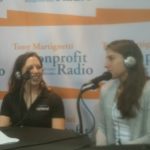I love our sponsors!
Do you want to find more prospects & raise more money? Pursuant is a full-service fundraising agency, leveraging data & technology.
WegnerCPAs. Guiding you. Beyond the numbers.
Credit & debit card processing by telos. Payment processing is now passive revenue for your org.
Get Nonprofit Radio insider alerts!
Listen Live or Archive:
- On Fridays at 1pm Eastern: Talking Alternative Radio and tune in
- Listen to the June 22, 2018 archived podcast
My Guests:
Steve Jacobs & Kristina Villarini: Storytelling
Our panel from the Nonprofit Technology Conference helps you find and tell your stories. They have terrific advice and strategies, and they are Steve Jacobs from Precision Strategies and Kristina Villarini with Lambda Legal.



J
essica Meister
Julia Campbell: Free Facebook Fundraising
 Julia Campbell reviews Facebook’s free fundraising tools that get your community to fundraise for you. She’s principal of J. Campbell Social Marketing. (Also recorded at the Nonprofit Technology Conference)
Julia Campbell reviews Facebook’s free fundraising tools that get your community to fundraise for you. She’s principal of J. Campbell Social Marketing. (Also recorded at the Nonprofit Technology Conference)
Top Trends. Sound Advice. Lively Conversation.
Board relations. Fundraising. Volunteer management. Prospect research. Legal compliance. Accounting. Finance. Investments. Donor relations. Public relations. Marketing. Technology. Social media.
Every nonprofit struggles with these issues. Big nonprofits hire experts. The other 95% listen to Tony Martignetti Nonprofit Radio. Trusted experts and leading thinkers join me each week to tackle the tough issues. If you have big dreams but a small budget, you have a home at Tony Martignetti Nonprofit Radio.
Get Nonprofit Radio insider alerts!
Sponsored by:
Processed on: 2018-11-11T23:51:29.902Z
S3 bucket containing transcription results: transcript.results
Link to bucket: s3.console.aws.amazon.com/s3/buckets/transcript.results
Path to JSON: 2018…06…395_tony_martignetti_nonprofit_radio_20180622.mp3.384267972.json
Path to text: transcripts/2018/06/395_tony_martignetti_nonprofit_radio_20180622.txt
Schnoll buy-in hello and welcome to tony martignetti non-profit radio big non-profit ideas for the other ninety five percent. I’m your aptly named host. Oh, i’m glad you’re with me. I’d get slapped with a diagnosis of gas just axis if you made me stomach the idea that you missed today’s show storytelling our panel from the non-profit technology conference helps you find and tell your stories. They have terrific advice and strategies, and they are steve jacobs from precision strategies and christina villarini with lambda legal and free. Facebook fund-raising julia campbell reviews facebook’s free fund-raising tools that get your community to fundraise for you she’s principle of jake campbell social marketing that’s also recorded at the non-profit technology conference, responsive by pursuant full service fund-raising data driven and technology enabled twenty dahna slash pursuant radio by wagner cps guiding you beyond the numbers wagner, cps dot com bye tello’s turning credit card processing into your passive revenue stream tony dahna slash tony tell us the’s non-profit technology conference interviews air so long i don’t have time for tony’s take two today, let’s go right into storytelling. Welcome to tony martignetti non-profit radio coverage of eighteen ntc non-profit technology conference from new orleans at the convention center, we’re sponsored by network for good, each interview at eighteen ninety cia sponsored by them providing easy to use dahna management and fund-raising software for non-profits that work for good. My guests are steve jacob he’s, managing principal at precision strategies strategies voice crack out of fourteen it’s a strategy it’s, a very dignified company has nothing to do with the way my life is the best snusz thank you, thank you, steve, don’t don’t i’ll prompt you want your let me let me introduce you properly, and christina villarini she’s, the digital director at lambda legal welcome. Thank you. You’re welcome welcome, christina and your workshop topic is make him laugh, make them cry, make it rain. Christina yes, too much, too much emphasis on video, and we’re getting away from the lost art of britain. Storytelling is that with the seminar is all about i mean it’s a little bit of everything on, and we’re talking about social media. We’re talking about putting clients and the folks that we serve first, then allowing them to share our lived experiences and with our constituents, and that could take many forms depending on the medium that you work in, um, it could be long form content like a block. It could be video there’s a lot of really cool tools that are allowing folks to sort of unity the user generated content sort of burst that’s happening right now where people are, you know, walking around with devices that are capable of doing really complex things that we couldn’t do fifteen years ago or ten years ago. So i think there’s a lot of mediums that people can use to tell stories. But you, if you move away from that, nothing good is gonna happen, okay? Yes, yes. God, steve, you wantto control yourself? Sure. Yes, something yourself. I mean, the topic. Yeah, absolutely. So, you know, what we were thinking about when we developed this session was just that a lot of non-profits have have trouble telling really powerful stories about the work that they do. Oppcoll and i think often this is the this is the gap that you find between traditional communications directors and people like christina who are digital directors. Traditional communications directors have a mindset that’s very focused on delivering content that can then be translated by journalists to tell the story of the organization that they represent, and often those that plays out as a press release or as a very high level, policy focused interview on dh, not telling the stories of the people whose lives are affected by by the non-profits work. So, you know, no matter what you know, christina works at lambda legal, which represents the lgbt community in court. But regardless of whatever non-profit organization, their mission is always going to be representing someone and someone’s, right someone’s needs, and that that means that there’s an emotional story behind it. And if you want to marshal the support of the people who want to give you money so that you can keep doing your work, you need teo give them a reason to do that and telling them, you know, that’s, just the dry statistics. And, you know, wonky policy notes is not going to really spark passion in the hearts, minds and most importantly, wallets of your supporters. Okay, so we want to do good, good storytelling, good quality storytelling. Christina, do you ever give her focus on the, uh, on the attorneys when the paralegals, you know, as the as the heroes and heroines of the story rather than the clients. Yeah, actually, lambda is really land is really focused on on both the superstar attorneys that do the work every day. We’re really fortunate to have some of the greatest civil rights lawyers on the planet doing this work every single day and land. This specifically is unique because a lot of the folks identifies members of the lgbt community or is like, really strong allies. So this work is not just like what they’re good at. It’s also like mission driven and purpose driven for the u s o there was a campaign a few years ago where they, uh, we did video about some of our attorneys on the staff and called them the dream team because it was literally folks who, like, you know, one marriage equality who you know, lawrence v texas like these air, the folks who really changed the landscape l g b t people and people living with hiv in this country and and made it possible for us to even conceive of full equality for everyone. Yeah, i did an interview yesterday with a panel, and we talked about making staff the hero of the story not obviously you focus on your clients as well, but but everybody in the chain that makes that makes that impact that makes that outcome so positive, you know, focusing on them as well. So good to hear that you’re you’re focusing on the dream team is, well, the attorneys and i’m erin on staff, you know, i mean paralegals mean, yeah, no intake intake, processors, caseworkers, they they’re they’re they’re heroes to yeah, atlanta is great. A lot of folks don’t know that we actually have a free legal help. Us and it’s it’s tough to explain to folks who aren’t familiar with the sort of impact litigation world, but people will call in and ask you no questions like i live in ohio. My employer just found out that i’m hiv positive. What are my rights? Can i get fired? What does that mean? And so now relate this back to the storytelling, right? Okay, so so the storytelling pieces that, you know, some people are brave enough to allow us to litigate with on behalf of of themselves. They’re not like anonymous plaintiffs, right? So one example is lambda legal and outserve sldn. Are two of the firms that are representing litigants in the trans ban, the trans military band belle george yeah, and all of our plaintiffs, the individual plaintiffs are named plaintiffs and each of them, i believe three of them are actually enlisted in the u s military, and that gives us a unique perspective because they’re able to present what it is actually like to be a trends americans soldier in a climate that is basically telling you that you are not qualified. Teo, do your job. Wei had katie schmidt who’s, a staff sergeant who’s, one of the plaintiffs in that case in our office, doing a reddit, eh? And actually, this week she was telling her story. She was able to tell our stories live real time alive question right to people who are not our constituents, right? Like a younger demographic, maybe mostly male who have really strong political feelings that maybe don’t jive with what we do. So those types of stories air like, invaluable for us to do what we do know, yeah, i mean that i am a i think, you know, i regrettably wasn’t wasn’t a part of it, but i was i was so excited to hear about it at this point that it wasn’t your idea, so is every good idea i don’t like quite as much, but what i think was so important about that was like like christina was saying who’s reaching a new audience that is not the traditional lambda legal audience like she said, read it is sort of ah younger, younger mailer, wider community come and buy by going into that space and having that plaintiff tell tell her story hyre she made herself into a human being to them instead of, you know, a type that they read sort of about it’s time for a break. Pursuing their newest paper is the digital donation revolution, thanks to amazon’s one click to buy and recommendations based purchases your online donors have higher expectations of you doesn’t matter to them that you don’t have amazons budget and expertise. Do you want to measure up? Get the digital donation revolution you find on the listener landing page? Tony dahna slash pursuing radio now back to storytelling so let’s explicitly translate this into general lessens around about storytelling. Good versus mediocre. Sure. So i think the point you were making earlier about about establishing heroes is very important. People like to think of themselves as the kind of person who would be a hero rather than the kind of person who would be a victim. So while it’s very important for us to tell the stories of the people that that we’re serving on dh who need our help, it’s really important to include the voices of the people who are doing the helping and are are playing are playing that role because then that’s that’s sort of the avatar, that the supporter khun see themselves as playing when they sorry using video game terminology, but when when they donate more, when they support the organization, they’re not thinking of themselves as you know, necessarily that the person who has been victimized that’s important too, of course, but they’re by telling the story of that person who needs the help through the voice of the paralegal through the voice of the lawyer, or if it’s not illegal organization you know someone else, they think well, that’s that’s the way i khun khun b, that sort of hero that i see when i watch tv or when i watch movies to sort of live out that that role that i want to experience in my own life, i i also just want to add that i think in this particular climate, in this era of, like fake news and what’s authentic and what is true, it is really, really empowering toe let the person’s how their own story and to give them the platform, because lambda has a large platform where, you know, a forty five year old organization and both our supporters and our enemies, our opposition, are looking at us and seeing what what cards were playing every single day. So to be able it’s really important to me to be able to turn over that platform to our constituents, to our plaintiffs and let them tell why they are fighting what what is actually important to them? Like we are a law firm, we’re a civil rights law firm, we’re going to keep defending what we what what aligns with our mission until we can’t do it anymore. And so we went, right? So i think with the cases that we survive tried to be advocate internally to allow us to give more of the mike. To those folks and what other platforms you are not platform. What other methods are you people turning cameras on themselves? Yeah, what? What are you doing to empower the the heroes? Yeah, so the user generated content will will set up like we’ll use, like blue jeans and have lawyers and different offices have conversations. I’ve done a couple of different kinds of, like, you know, five minutes, five questions with one of our attorney is on, like facebook that will post a couple of times a month where we just break down was happening like you taking the questions from from the people watching the live stream i’m taking questions, usually in the comments from other other posts that we made so like, so if we see recurring themes and somebody doesn’t understand it’s like, okay, i need to get this lawyer on the phone who khun distill this because most of the time they don’t even know that they’re speaking in the legal language legalese, right? It’s what’s comfortable for them. So part of my job is getting everybody out of their comfort zone, and using different vehicles were used. Facebook live! We use facebook live twitter way love social what have you done on twitter? Tio tell stories we’ve done a lot of joint chats with other organizations will also take, like users a minute, questions on those in advance any hashtag do you want to share? I mean, we people can look at we’ve done a few i mean, when it comes to the most recent ones are on courts and judicial nominees, so, like stop far or no dunkin like just like, you know, any negative of a judge’s potential nominee last name is going to be what you’re looking for. The twitter point i think that there’s a there’s a specific example that that we sight in our session sided here, man, back on non-profit radio well, well, the larger point that i want to make is that, you know, we can use social media to tell stories from real life, but the use of social media actually establishes its own storyline, right? And so the example that i’m thinking of is when, when trump announced that he was going toe ban transgender people from serving in the military and lambda under kristina’s leadership tweeted this really, really funny tweet that sort of cast lambda as as the superhero as you were saying, where what was the exact phrasing so area goldberg, my incredible, talented deputy digital director who’s holding down the fort back in new york, tweeted out, puts on a cape made of legal briefs. Yeah, there you go again puts on like two asterisks like an action on, dh said puts on a cape made of legal briefs rang with quoted hill implementation like the bat signal going off all right, and was i remember i saw it again, you know, a great idea that wasn’t mine, but i was very excited by i saw this and i was i just thought, this isn’t this is an amazing time cape on and and the response that that we saw immediately was so strong because it was funny, right? And that was that’s part of what our session is, right? We’re talking about telling the emotional story that might make you cry, but also something that will make you laugh because, you know, this is every every non-profit especially land illegal. If you focused too much on the problem that you’re trying to fix, it gets a little too sad it gets a little too overwhelming, and so you need to have a little bit of a sense of humor about it and this this this particular tweet and a lot of other the tweets from lambda legal at lambda legal, everyone should check it out. It brings a lot of sense of humor to the really important work that they do and what i also thought was really, really great. I’m just bragging on your behalf way hold that point, but this also does is inform people about your about the brand total personality of an illegal legal we don’t take each other, take ourselves so seriously that we can’t invoke superheroes, you know, in the face of, you know, gross discrimination, you know? So the brand brand benefits from people knowing that it’s ah, it’s, approachable, you know, we’re thinking we’re thinking superman, yeah, i mean, so one of things i’m really proud of is i i kind of came from a traditional media background, so i’ve done my media direct their style work, and i’ve been a journalist. I worked, unlike celebrity beats for several years, so i have a pretty good understanding of, like, the sort of earned media side as well as the tax side, which is unique for digital people. But i understand that there are certain things that you have to do to engage a particular kind of persona and, like having content that is sound bitey and that a journalist can throw into a piece that is our position and they don’t have to call anybody is really important, you know, and having, you know, that funny moment or that first moment that they’re going to use, like we’ve had a new a gift of the undertaker put in like a daily dot piece, you know, as like, this is what land the legal said about something gross that’s happening and that’s like a particular phenomenon. Did any media pick up the the putting on the cape? Yes, they like the hill has run a lot of ourselves, a lot of stuff on social. Yeah, it’s really fun and it’s easy to do, it’s the humanity of the work that you’re doing right because you’re really and the sad part of it is that it it’s giving somebody else something to do. Besides, for being afraid all the time. What do you mean? What? So this is what you told your point, steve there’s one that i caught you when i interrupted. Now christina’s interrupting, but it was my digression, but now she’s interrupting, we’ve fallen down the back here and we’ll get back out. It’s my job to get us back out, she’s saying smart things like, well, it’s, that because they’re reacting to the fear of of whatever is in opposition of your true value or your true mission, right? So when people saw the trans band, they were freaking out, they were freaking out for their neighbors and their brothers and their sisters and and the people that are paid to protect them, who are now having their privacy ripped out from under them, a right that they’ve pretty much earned because they decided to try and protect us all over the world have involve alt-right right? So the rand study has is quoted at somewhere between, like ten and fifteen thousand trans troops like who are deployed, who are active, who are having their lives, like shifted from under them. So this is really these rial world, right, it’s getting that story right but it’s also that, like people saw that and trans people were scared. Trans people were scared about what this administration is doing. Are they targeting me? What does this mean? Is this legal? And we gave them number one. We told them, like, we’re on it, we’re watching this and number two, we’re like, you know what? Take a minute, we got this, we’re going to be fine. And so i think it gave people a second toe, like, step out of their own fear and know that there are people who are going to fight for them, you know? And so this is actually related to the point where that i that i was trying to say earlier, so i know i know everyone’s going to be fixed? Why di grab stuff? That was so the two points that christina was just making the point that you made about approachability? I’m not tie them all together right now, so you know any any legal response organization one welcome metoo steve jacobs non-profit radio he’s sitting in the middle of may as well be the host. What? Garrett, just change the focus company out. Oh, just crop me out like i’m ready for a career. Change so you know, any any legal response organization can put out a press release saying, you know, we are we’re going to sue and that’s something that could, you know, make a person who was concerned about this issue. I feel a little calmer and know that they’re on it if they see it, if they see it right. So that’s one issue and secondly, even if they do see it it’s a press releases air pretty dry, right? And so putting out putting out a tweet along the lines of throwing on a cape made of cape make made of legal briefs, it does make you feel like, okay, one i know someone’s looking out for me, and they are like me, right? Like, they’re they’re they’re like me, not just because, you know, it’s, lambda legal, and so it represents the lgbt cubine a community, but they’re they’re they’re fun loving, you know, not not just super serious lawyer types, and that makes them like you said virality approachable. Yeah, and so makes them approachable and not just approachable in the sense that, you know, i feel good, but people were tweeting back to them in that. Moment to that particular tweet and what i thought was particularly great, and this is what i was going to stay way back when is that they were ready, tto they being cristina and her team were ready to tweet back to these people who were responding to them in the moment? And so people were saying, oh, i love you and we stayed they were there to say, i love you right back, and then people were tweeting really funny animated gifs at them, and then they had photos ready to tweet back of them, and so it became a conversation. And so that’s what i meant before when i said that the social media story is a story unto itself, it’s not necessarily telling a story from from the real from the real world. So and the thing is that the other social media users could become part of that story. They become characters in that story, and so that’s and so they’re tall telling the story together and it’s a really participatory experience does not all contribute to long term engagement mean this’s opening conversation long term engagement when the dollars how that’s going right i was going to say whether weaken you can only draw the line, but whether that’s going to translate the dollars volunteers just mohr sharing of your content. I mean, all those things are valuable. Yeah. I mean, that was just that opening conversation that was a really popular engaging on most amplified sweet. Probably that month, people just went crazy for it. And we raise a lot of money that day. Oh, that specific day? Yeah. That specific day we raised about forty grand off of social media alone. It’s way beyond what’s. Typical. Yeah. That’s yeah, yeah, that and that’s legitimately like folks like, okay, who were the orders that were going to donate who’s going to fight this thing? Well, it’s going to be lambda legal because they’re here. Your aunt s o you know, we set up specific source link that went to a page individually from each each social platform. So we had, like, a facebook driving link and it’s what are driving link to our donation pages and were able to generate a lot of money in those days and didn’t you see the and you said just said now forty grand from social but i thought it was just forty grand just from twitter. I think it was just one twitter on dh and it’s very hard to raise money from social media it’s normally through through e mail or through ads, and so when you can raise a lot of money through social, that means you’re doing something really well, yeah, i was eight hundred eighty two donations for about forty two grand. Ok? Any let’s see challenging stories? You know, things didn’t go so well doesn’t necessarily have to be at lambda legal. It could be i mean, you seem to be willing to share, but it doesn’t have to be. But you know, things that you learned a lesson you want your client, steve learned a lesson you don’t name them, but, you know, it could have been done better. As i look back, i thought, yeah, maybe here’s where i think we went a little wrong durney tells of that. I mean, i think that the the hardest lesson that these organizations i need to learn is just that that, you know it is it can be really hard tto find these stories because, you know, like the old adage when you’re inside the picture, you really can’t see the frame, and so, you know, for example, on organization i used to work with, you know, several jobs ago, they were and still are, i won’t name them, but a public health organization and, you know, they had all these really great stories about, you know, about doctors and local communities, saving people’s lives, and, you know, they wanted to talk about building a hospital and, you know, that’s building a hospital’s, important units, access and everything that’s work there, right? Yeah, but it’s it’s not exciting, right? And so you want to hear the story about, ah, in fact, here’s a here’s a really great example, so they didn’t they didn’t. They didn’t want to be certain they’re saving lives every day. Exactly. Um, it becomes mundane cancer or a traumatic accident or something, right? You want to tell those stories? And so we wanted they wanted to do ah campaign specifically about cancer in the developing world because in the developing world, you think about hunger, you think about aids, you don’t think about these sort of non communicate diseases, and they wanted to do a campaign around that. But they all wanted to talk about stats and how because they think it’s surprising that there are so many more people, you know, in sub saharan africa suffering from cancer, and you wouldn’t think about that you think of, like, breast cancer, a sort of developing world issue, and so i wouldn’t take my advice. I said i wanted to do a story and finally convinced them to do a test where one email was focused on telling just the stats, the way they wanted to and the other they let me find someone who had a story, and it was about a dad whose whose daughter had cancer and about how he he didn’t have access to medical help, where he lived in about all the sort of this sort of the sort of odyssey that he went on in order to just get medical help for his daughter and save saved her life. And, you know, it was it was mind blowing the difference, right? The version that told the story of a dad and his daughter just i don’t remember the exact numbers, but it it blew the other one away in terms of dollars raise. And so i think, that’s that’s the biggest challenge that i think a lot of non-profits faces just stepping outside of the frame, talking to i think i think it’s really important for people who work at non-profit organizations to talk to people who don’t work there and tell them about the work that they do and see what these sort of you know, quote unquote real people respond to and what they don’t win and then also watch when their eyes glaze over and that’s how you can learn, you know which of the stories that are worth telling on dh which are sort of the supporting facts that you throwing later on, we shall have ah, couple minutes left together, like two, two and a half. So what else do you want to share about storytelling? Good, bad empowering the empowering the the volunteers and heroes within tell their own what else could i mean? It’s a slow burn? I think you have to know you kind of have to be in it for the long haul. Not everything is going to raise forty thousand dollars in a day on dh sometimes it’s going to take a minute? You know, you have to continue with the touchpoint ce that that, you know, are important tio to the message into yourself because your constituents may not necessarily get it at first, we have some folks that lambda legal who are like, well, i don’t really understand the trans bathroom thing like, well, that’s not really our issue, i don’t really understand it. And it’s it’s coming, obviously from a position of privilege and never having that experience, but it’s also coming from a fact of like, you’ve never it’s access its its experience, it’s you know how you present and if you’ve never had that experience where somebody like stopped you from walking into a restroom or miss gendered you or if you’ve never had to live with that. It’s it’s easy to not get it s o for us, it’s an important issue, andi, we’re going to keep fighting for it, but our constituents, you know, some of them don’t get it. And that doesn’t stop us from continuing to tell those stories from continuing to advocate for, like gavin grimm and other folks who were really trying to make it make that access fair and equitable and safe for everyone, all right, it’s a long haul, but it’s worth stay true to its worth telling story. Yeah, yeah. And i think the one thing that i would add their understanding that we’re running low on time, it’s just that i think that one of the reasons we wanted to do this session was because there’s a very strong trend, particularly digital fund-raising right now to focus on minimal, like at least, like tiny little tactics that are that have been proven to raise the needle a little bit. But the more and more you take those sort of testing optimization sze, where you’re just changing the language a little bit. Are you using a certain kind of graphic or a certain kind of like urgency approach, the more you start to mistreat your community of supporters and treat them more like atms rather than people on how much can you do that anyway, right? You get every post can’t be can’t be groundbreaking and and rid bold colors, you know that it’s, right? But if you’re on some emails, if that’s what you’re getting everyone’s gonna be exhausted and turn you off. All right, we got to leave it there. The other reason you did your session because you knew you’d be on non-profit radio here. Martignetti non-profit radio it’s right behind you, it’s bona fide it’s on the back. It has to be true. Okay. They are steve jacobs he’s, a managing principal at precision strategies, and cristina vila rina she’s, digital director at lambda legal. Stephen. Christina. Thank you so much. Really. Thank you. Thanks a lot. This interview is sponsored by network for good. Easy to use donorsearch and fund-raising software for non-profits. And you are with tony martignetti non-profit radio coverage of eighteen ntc. Thanks so much for being with us. We need to take a break. Wagner. Cps before they go beyond the numbers, they cover your essentials. The nine. Ninety and the audit. Check him out at wagner. Cps dot com start your due diligence there. You can use the contact page there or you know my preference. Go in real life. Pick up the phone. Talk to the partner. Ye hooch doom. He will take care of you. Answer your questions. No pressure. Weinger cps dot com now, let’s, go to free facebook fund-raising. Welcome to tony martignetti non-profit radio. Coverage of eighteen ntc it’s a non-profit technology conference in new orleans with the convention center. This is day three of our coverage. The interview is sponsored by network for good, easy to use donorsearch and fund-raising software for non-profits and the interview is with julia campbell, author trainer, speaker jake campbell, social marketing welcome, julia campbell. Hi. Hi, tony. Happy to be here. Good to see you. Good to see you two. And the show’s. Former social media manager. Yes, i am. Um i take full credit for your success. Actually. Just getting take full credit for my success. Up to about three years ago. Three years, three to four. Not long ago, i was at least three. Yeah, yeah, okay. And your session topic is all about facebook. How to use facebook’s free fund-raising tools to drive donation? Yes, and because this is the week where mark zuckerberg just testing buy-in testified this week, monday and tuesday or tuesday. It was monday and tuesday in front of two different congressional committees. Duitz because of all that and the russia interference and the cambridge analytica, eighty seven million people who are down on facebook this month, yeah, what do? You say non-profits questioning should we still be fund-raising there? Should we still be there? My boys just crack that’s in there. Uh, okay, what do you say to the facebook skeptics? Because there there is a you know, the leak facebook movement? Yeah, little sanctimonious waist look movement let’s acknowledge it. Why do you say thank you? Because people keep saying their going to delete facebook, but the reality is still almost two billion people it’s still growing still, even if one hundred million people that really wouldn’t even make a one point nine billion right? All right, i think the real issue is that facebook’s currency is trust it’s built on trust and that trust is eroding. So people, even if they’re not losing use that they’re not deleting facebook directly, they might be using it less and certainly he’s spending less time on it, maybe signing in less. So i think in that way there might be some blowback for non-profits but it’s too early to tell, but i yeah, i would like to thank Mark zuckerberg for the 12 hours of testimony the day before my session, the optics where your little not alright so i’m sure, it came up right? People ask, you know, should we still be their art? But we got to keep it in perspective and who knows, you know, seems unlikely. This will be the downfall of facebook now the stock price, maybe that will recover who don’t even know if that will, but anyway worth acknowledging, you know, there are still two billion people there. Yes. Yeah, and they’re changing some policies. They’re trying to be more transparent. They’re trying teo encourage people to revisit their privacy details there being they’re trying hard. I don’t think they’re doing enough, but i think that’s a little different conversation. I also think facebook is kind of the tip of the iceberg for all the data we give up every day. Just having a smartphone. Yeah, yeah, that’s true, depending on what network you’re on winning on who your eyes is. What, what? What wifi? You’re on from moment to moment, the vulnerabilities built in yeah, that is a bigger conversation. Let’s, go to facebook and talk about some of the free tools. What let’s, surely a numerator couple that we can talk about in twenty five minutes or so? Sure. So the way we set up the session was i did a brief overview of the main ways that you can donate on facebook right now. So if you have, if you register with facebook, i’m talking about if you’re verified registered, you send in your five twenty three letter and you give them your bank account number so they can make a direct deposit to you. If you have all that set up, you can put that donate button on your cover page, you can put donate buttons in your ads, in page posts and on facebook live video’s okay, so those are the four main ways. Is that a program that you know what’s the programme called where you get authorized, but that donate it’s called facebook payments? Yeah, use and charities have to provide their five, twenty three letters, okay, but you’re getting authorized through the program called facebook payment. Yeah, so you you would go, i think it’s facebook, dot com slash donate or you could just, you know, google, how doe i signed up for facebook payments? Then you will be verified by facebook and it’ll be that to tap donating so i would tap on the donate button? It would bring up a screen with suggested giving levels, and i would tap my level or it enter another amount. Click tony because it’s linked to my credit card if you don’t, if you don’t have a credit card, then you will be asked to provide a credit card or link. It’s pay pound individual to tap donating. So it was. It is a pretty easy name since the charity bank account. Yeah, who sets the ask string on that on that page where they suggested giving amounts. Are you set your own? Yes. Yes. You have that? Yes. That’s basically the only flexibility that you have. That is a thing. All right. Okay. So that’s facebook payments? Yes. What other free tools that can be okay. Those are the four. Those of the four ways. So what’s really interesting now is that we’re seeing we don’t missed one of the four way there’s the donate button on your cover photo today, but not the facebook payments. Yes. Donate button in a page post like if you post to the page. Donate oh, these are all different programs. Well, no, they’re not different programs. They’re just different. Features you could put the donate button on any of the pages once you get to these four places. Yes, once you’re authorized facebook payments, okay, oh, i missed that. Alright, i thought they were each four different programs no wash can imagine. Well, we’d just like to sign up once, and you are able to raise money those four ways the other way, which we explored ah lot in the session, our facebook fundraisers, which is where a person sets up a fundraiser like a peer-to-peer kind of fundraiser on your non-profits behalf. So in my session, i had two case studies of non-profits that have had really wonderful success with getting their supporters to start facebook fundraisers for them so it’s it works the same as any peer-to-peer platform. Okay, what’s different about it on facebook? Yeah, facebook, facebook, live! You can use facebook, live, put it, donate button people can see if i donated it would say julia donated and it shows you how much money is being raised in real time. You can start your own facebook fund-raising page that has, like a little thermometer, just it looks like, you know, a crowd rise or a go fund me, paige it’s got all the list of the donors how much you have raised towards your goal, your story? What? You’re raising money for different giveaways at different levels? No, i don’t think i mean, i think you could do that. But facebook fund-raising does not have that. Not like kickstarter. Okay, no. So the real incentive is tio, you know, the real incentive is that it’s, so easy to do if i want to donate my birthday and have everyone give ten dollars rather than, you know, buy me some coffee mug or church key. Then i can set up a facebook fundraiser, link it to the non-profit like that e i don’t know. It’s your favorite client on your your mind. That mug was amazing. I’m so your i bought five coffee mugs while i was here. I don’t know what i’m talking about, but i remember that with mine is the one you shattered on your kitchen floor. That was the one. Okay, i think that probably right. So so instead of, you know, getting gifts, you can it’s like anything else. Except the key. Is that its true face? So it’s where people are spending their time and it’s really easy to do so you can reach a big group of people with one click. How do we induce our supporters to do this for? Well, i think the first thing you need to do is explain to them it’s an option. So what kind of drives me crazy is when charities come to me and they say, oh, i have a donate button on my website, but no one’s donating and i said, well, did you? Did you tell anybody you have you actually asked your donors? Are you showing them how to use it? So with facebook fundraisers, if it’s something that you want to do, you need to create a bit of a plan to promote it and to educate people how to use it? Because not everybody knows how to do it. So it might involve a youtube video walking people through. Maybe you could do a facebook live talking about it and and sharing it and saying, this is an option now i know with both the polaris project and mental health america, which were the two non-profits that joined me in my session, they both feature the fundraiser is prominently on their website on their facebook page, so it’s the first thing you see when you go to their facebook pages, the list of people and they’re different fund-raising events, but they do a very concerted effort to promote it on dh they go, yeah, so you you really have to you have to let people know that it’s there and it’s something you’re trying and address people’s concerns because they might have concern about how to do it, about how to do it about facebook, you know, there’s a million different concerns that people could have, okay, what else do we have so use of facebook? Yeah, so i think the what i said in my session, what comes up all the time? And i know people are listening and watching this right now and, you know, we need to address the question over twelve thousand people, right? And i know that they’re getting angry because we haven’t. I haven’t addressed the fact that when you do a facebook fundraiser, you don’t get the donor information so you might get a name of first and last name of her, you don’t get their information, so it might not be the best tool for you. It certainly shouldn’t be your only fund-raising tool it’s not a tool to use if you want to grow your donor file. But if you want to raise awareness, raise, you know, a lot of money in a short period of time, it might be worth looking into, but i yeah that’s, that’s a huge con and there’s no way of acknowledging the gift, then you these books and then auto acknowledged. Yes, they send, like a tax receipt. Like you can customize it either it’s strictly from facebook, it’s strictly from facebook because that’s the person knows they made a donation, but they’ll never you can never contact them know unless they say, well, can you look up? Can you try to search there? Yeah. You could cross reference with the database. I mean it’s a little more. Or even just search on facebook, right? So what i recommend doing these are friends of these air friends, of friends, of your friends, friends of your followers. Exactly. So i would i recommend, first of all, really acknowledging the person that sets up the fundraiser for you because you have their information. You know, we’re linked to your face or sank them, but also send them some text that they or even better yet, a thank you video that they can share on their fund-raising page or they can send to their focus because you really don’t have the ability to make that personal touch with these friends of the only ok. S o that’s, that sounds like a very good strategy has asked your asked the fundraiser yeah, tio, send the video, show the video through the outreach to them. Yes, you gave what about? I don’t know if this is a bad practice asking the fundraiser to share the information of the people who gave because they’re that person’s friends and then you and saying, you know, we only want what we want to do is thank you, but then you can’t go further unless you say we want to thank them and try to get them engaged. What about that strategy? Trying to get your friend to give up their information? I think it’s not scalable if you have a lot of people fund-raising for you, that could take a lot of time if you are only dealing with maybe ten of your supporters doing fundraisers for you then that might be a good strategy, but yeah, i don’t think it’s i don’t think it’s scalable. I’m not one hundred percent sure it’s ethical. I don’t know what you definitely can’t put them on your email list. Um, i would say, you know, that might be a good strategy, try it out and just sent a thank you and an invitation to get more involved. So, you know, thank you for your gaff. One message here is, you know, a way to get more involved if you want. We haven’t put you on any mailing lists. We just really genuinely want to thank you for your donation. That could be a good strategy. I don’t think that many fundraisers would i know that i wouldn’t give up that kind of information to a charity as much as i love them not wait, not even have it because these are my facebook friends. I might have their emails, you know, so okay. But if you did, you would be reluctant. Alright something. Think about it. Yeah, bad practice. You don’t think it’s an awful practice, you know it’s something to think about and i’ve been thinking a lot about that, maybe nobody no, but let’s test it right? This is this is the biggest question i receive by far around facebook fund-raising tools why would we use them if we don’t get the donor information? And to that? I say it’s, it’s, facebook’s world and we live in it. You can’t fight facebook, i’m not saying that the tools are necessarily the best option for all charities, but there’s something you have to look at, i mean facebook’s completely revolutionized the way we communicate as humans and it’s going to revolutionize the peer-to-peer fund-raising industry it’s going to happen? It’s going to start linking with other sites? So if i do a fundraiser on facebook it’s going to start linking with blackbaud and crowd rise and causevox and all of these different crowd funding platforms and then i don’t think it will be it won’t be solidly unstoppable, i think that’s that’s gonna be where we’re going to do peer-to-peer that’s just what i trends that i’m seeing. Okay, okay. Trend, trend predictions. All right. A futurist your futurist? Yeah, they had that to author trainer, speaker? Yes, other trainer. Speaker that’s where my lincoln for a file like that? No, i got this from the ten description. Okay? And ten has the speaker page. Okay, i i didn’t even look at my speaker. Paige right now i know it’s out, but that’s what it says it’s funny. I gotta take a break. You’ve heard the tell us moughniyah lll from lee elementary school for tello’s credit card processing lee elementary school, where they’re getting a monthly donation from tell us for the credit card processing of a parent owned company. Do you want more revenue? Important question? Would you like that revenue to be recurring each month? Ask the people who are close to your organization who owned businesses to switch to tell us get started at tony dahna slash tony tell us now, back to free facebook fund-raising so what else? Okay? Because i mean it’s simple. What more? What more can we do on fund-raising? I mean fund-raising on facebook yet we still have some time together. Yeah, so i think it’s important. Teo really evaluate how you know your goals for using it so i wouldn’t completely write it off just because you don’t get the donor information what’s interesting to me is the generational divide around this issue because the two non-profits that i presented with their digital media directors air really young, they’re in their twenties, they have xero problem with it, they don’t understand the big snusz around not having the donor dina money, they’re making, they’re doing their job, we’re hearing about their raising awareness, they’re getting the word out, they are increasing their they’ve grown, their facebook fan page is they’ve doubled their facebook fan pages thie amount of followers on them, they i think they’re taking a little bit of ah bigger picture view, and they’re not really worried about thiss ability, because if it’s a five dollars, in their mind is sort of like if it’s a five dollar donor, well, we can get a thank you out through the friend. But it’s it’s not a person that might ever be gauged with us anyway, like they’re giving because their friend asked them it’s not like they saw something that we posted and responded it’s, their friend, that they’re responding to. So i just think, it’s very interesting you could tell in the session in the room, the older more traditional fund-raising people get really upset about it and the younger ones because they grew up like this, they grew up making payments with their phones, they grew up with facebook, so i just think that the generational divides very interesting around this issue, all right? Yeah. So i don’t know. Have you made a donation on facebook? Ever? Have you ever gone an invitation to donate? I don’t even remember that now, yeah, so when i log on, the first thing i see, almost every time i log on is a notification from facebook inviting me to donate or start a fundraiser there pushing this, they love it, i don’t know, i mean, it’s, you know, i don’t use i don’t use facebook to connect with not too much rain, and there are some pages that i like organisations i give too off line, but i’m not i’m not i’m not fans of a bunch of non-profit pages they’re pushing when fundraiser, so they’re really they used to be pushing facebook live if you remember you every time you log in, they would say want to go live wanted alive? It was like, oh my god, i don’t want to go live now? It’s want to start a fundraiser? I wanna start a fundraiser every time i log in, but i think that has advantages for charities because facebook is trying to get better press their trying to be the good guy again. They’re trying tio help people see that it can be a tool for good rather than a tool for, you know, evil for russians, for russians go god and hackers and horrible and bots to where that that scandal is only going to get worse. There’s no way, probably let’s not go political. Okay, um, what about what else? Your fake use? I mean, we’ve got we’ve got more time together, okay? We could. Is there another? Is there any other methods on facebook first and here the methods of fund-raising on face? Yes, i mean, what i’m seeing now is that it’s pretty impossible to get any kind of reach without paying for an ad so non-profit is posting and they’re doing what they’re supposed to be doing there. Putting a visual. They’re putting a video, they’re putting a photo. Organic reach has been killed, the organic reach is decimated with their latest algorithm. Change and this whole push tio have meaningful interactions, so i’ve been encouraging organizations. Teo explore may be creating a facebook group because a facebook group is it has a lot more capacity for interaction and it’s you see the notifications, if you’re in a group, what is this thing? The organization can join a group, you can start a group around a cause it would be around cause it wouldn’t be, you know, like the tony show, the tony show page or something, or the julia campbell social martignetti doing rube know there is because you could talk about the cause, you could use it, tio podcasting or something? Is that what you mean? Well, it’s groups are a place for people to talk about issues that they care about so you could start a group around your con animal welfare? Yes, climate change, right, homeless in oakland, california, right? And the more exactly and the more specific, the better hyperlocal you couldn’t. I wouldn’t start a group that’s like about homelessness, you know, or poverty eradication that’s huge in oakland, california exactly. So i think, or a neighborhood even a vocal in, if it if they’re enough people so i think exploring facebook groups facebook live is still hugely popular. Facebook loves it. I know when i do a facebook live video, it gets ten, twenty times the reach of the normal girls have been doing, i’ve done some shows treyz work-life so explore live video actually asking for money on facebook and posting a link to your donate page that, you know, i would not recommend doing that because facebook now is starting to show fewer and fewer link posts because they want they change their minds all the time. So now they want to go back tio what they’re calling meaningful interactions, and they want to go back to facebook being a place where you talk to your friends and family rather than a place where you see ten million adds cat videos, news articles, that’s very convenient, you’ll say the ads, but they have to be paid for exactly so they so it’s very, very hard to get organic reach. But what about the sense that you just you’re constantly chasing facebook and all they have to do is tweak the algorithm on groups are out of favor, and then all the work we put into creating our homeless in oakland group now she doesn’t get to reach anymore because of ah, code change, some program, a lot of things that i used to talk about and tell people to do. You can’t do now or it’s, not in fashion. So that’s an important point because i did a facebook live, we called it a boxing match with noah from noah from causevox and his point, and he made a really good point is that you don’t want to, you know, build your house on rented ground. You want teo, you want a customized co-branded solution that you can control, like network for good, like something like that that you can put your stamp on, but also you can get that information you can customize the welcome email that goes out. You can customize what people see when they log in. You can actually get their information, so facebook is just a tool. It’s a tool in your toolbox and, you know, spend time on your website spend time on your email. There was so many sessions around email, marketing, automation, donor acquisition spend time on that if your followers on facebook if your people are active on facebook if you’re comfortable and you have a pretty engaged presence, it’s, just something to explore, and it might work, like, for the organization’s case studies that i gave they neither of them set out to use facebook tools, they registered, and then they just found that their supporters wanted an easy way to raise money for them. And it was just a tool name into work so people can look at their pages. Polaris in d, c there, anti human trafficking and the mental and mental health america. Okay, go there, page like them, check it out, check it out. We still have a few minutes left together, okay, let’s, see getting your community fundraiser for you. Yes, talk about that signing up, registering. We know how to do that for facebook payments. So getting your community of fund-raising for you that’s i mean, what polaris does is they have a dedicated strategy and they’re focused on birthdays, so they have a sign up page on their web site. I think this is really brilliant where you can put your birthday in, and i don’t know what i don’t know what you get in return, but you put your birthday, and when you signed up for the email list, then right around your birthday, they have a siri’s of automated emails that go out and they say, hey, we noticed that you’ve donated to us you support organization it’s a, you know, two weeks out from your birthday, would you set up a facebook fund-raising for us and here’s how to do it? And then on their birthday, they remind them, and then, you know, i think they probably go into a different funnel whether or not they set up a fundraiser or not, but the key is just promotion and education around these tools, so don’t sign up for facebook payments and then call me and say no one’s donating because the first thing i’m going to say is, did you tell? Anybody, you’re promoted, did you promote it? Did you tell anybody? Did you have a specific system? I love the birthday idea. They’re focused, and charity water does that to their focused on donate your birthday, don’t your birthday obviously you could do you know a fundraiser for anything you want, but they’re focused and they have a strategy and it’s so much easier to figure out like k p eyes and measurements and metrics of success when you have a focused strategy like their goal and actually i don’t know their goals. So jos, i’m sorry if this is wrong, but i think polaris say their goal is to have twenty people set up a fundraiser every month or something that’s easily measurable unquantifiable. So i yeah, i just i think if i can impart any words to non-profits that are very stressed out about using facebook tools, i would just explore them. There’s a they have a website, they have videos that walking through facebook does and, you know, sign up, make sure you’re registered if you have a five twenty three number, so if someone wants to donate, they can if it’s not something that fits into your overall, you know, marketing fund-raising strategy. Then, you know, don’t do it. Okay, okay. Let’s see, what do you love about this work that you’re doing so i love it, okay, so since we work together, i published my book storytelling in the digital age, i do a lot of speaking and i do consulting mostly around strategic communications, so i do a lot of training around the actual tools on creating fund-raising campaigns, but another half is trying to create a message that works well online. So how can you know? Non-profits have a mission statement that’s five sentences filled with jargon very complicated. How do you distill that into you know, bite-sized pieces and make it easier and more palatable for online audience is because you can’t publish a textbook facebook or twitter or instagram whatever you use. So yeah, i really like it. I really like it. But that’s i think non-profits get hung up on the tools. But what? What is it you love about what you’re doing? What is that? I love. Why? Why do you love it so well? Because i feel like my job. My mission is to help non-profits become better communicators and to knock it so hung up on the tools so they come to me and they have a million questions about instagram and interim stories and snap champa and i kind of talk him off the ledge on them down and say it’s, not about the tools it’s about your message and it’s about your goals and it’s about what you want to accomplish. And then once we hash all that out, then we can pick the right tool. You know what i mean? Because you say, like, say, you go to a hardware store, they want to buy a hammer, you could build a house, or you could hang a painting. You know what i mean? It’s? Just a tool. Okay, we’re gonna leave it there. Okay? All right. Sounds good. She’s julia campbell, author. Trainer. Speaker futurist jake campbell, social marketing. Thank you very much. Thanks. Tony xero conceive you. The interview was sponsored by network for good. Easy to use donorsearch and fund-raising software for non-profits. And you are with tony martignetti non-profit radio coverage of eighteen ntc. Thanks so much for being with us next week. Storytelling too. And test quest. If you missed any part of today’s show, i beseech you, find it on tony martignetti dot com. Were supported by pursuant online tools for small and midsize non-profits data driven and technology enabled. Tony dahna slash pursuant radio by wagner, cps guiding you beyond the numbers. Wagner, cps, dot com bye, tell us. Credit card and payment processing, your passive revenue stream. Tony dahna slash tony tello’s. Ah, creative producer is claire meyerhoff. Family votes is the line producer shows social media is by susan chavez. On our music is by scott stein, you’re with me next week for non-profit radio. Big non-profit ideas for the other ninety five percent. Go out and be great. You’re listening to the talking alternative network. Get in. E-giving cubine hello, this is bruce chamlong, host of the web design and technology coach. Join me and my guests every tuesday from eight to nine pm as we discussed the latest in web design, social media, marketing, search engine optimization and technology way. Also discuss popular topics, including ward press, making money online, better koegler rankings and more every month way. Also feature the best unsigned music from around the world right here on talk radio dot n y c. You’re listening to the talking alternative net. Are you stuck in a rut? Negative thoughts, feelings and conversations got you down. Hi, i’m nor in santa, potentially ater tune in every tuesday at nine to ten p m eastern time and listen for new ideas on my show. Beyond potential live life your way on talk radio dot n y c hey, all you crazy listeners looking to boost your business? Why not advertise on talking alternative with very reasonable rates? Interested simply email at info at talking alternative dot com. Are you into comics, movies and pop culture at large? What about music and tv, then you’re in for a treat. This is michael dole. Check your host on talking alternative dot com. I’ve been professionally writing comic books, screenplays and music articles from fifteen years. Catch my show secrets of the sire at its new prime time slot. Wednesdays, eight p m eastern time, and get the inside scoop on the pop culture universe you love to talk about. For more info, go to secrets of the sire dot com. You’re listening to talking alternative network at www dot talking alternative dot com, now broadcasting twenty four hours a day. Are you a conscious co creator? Are you on a quest to raise your vibration and your consciousness? Um, sam liebowitz, your conscious consultant, and on my show, that conscious consultant, our awakening humanity, we will touch upon all these topics and more. Listen, live at our new time on thursdays at twelve noon eastern time. That’s, the conscious consultant, our awakening humanity, thursday’s twelve, noon on talk radio dot. You’re listening to the talking alternative network. Duitz buy-in













 Self-described “data nerd” Emily Patterson talks you through online tracking and analyzing of your offline activity. She’s founder of
Self-described “data nerd” Emily Patterson talks you through online tracking and analyzing of your offline activity. She’s founder of 


